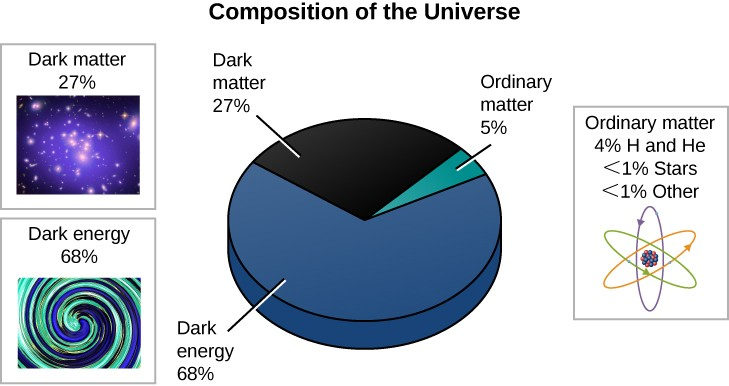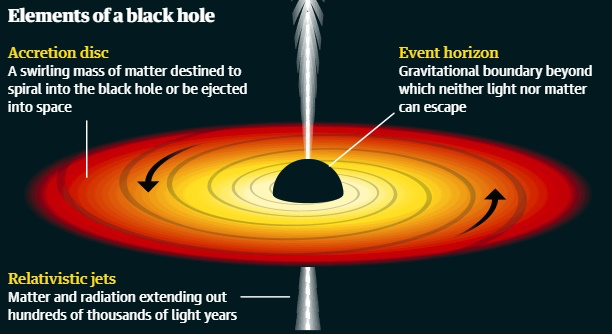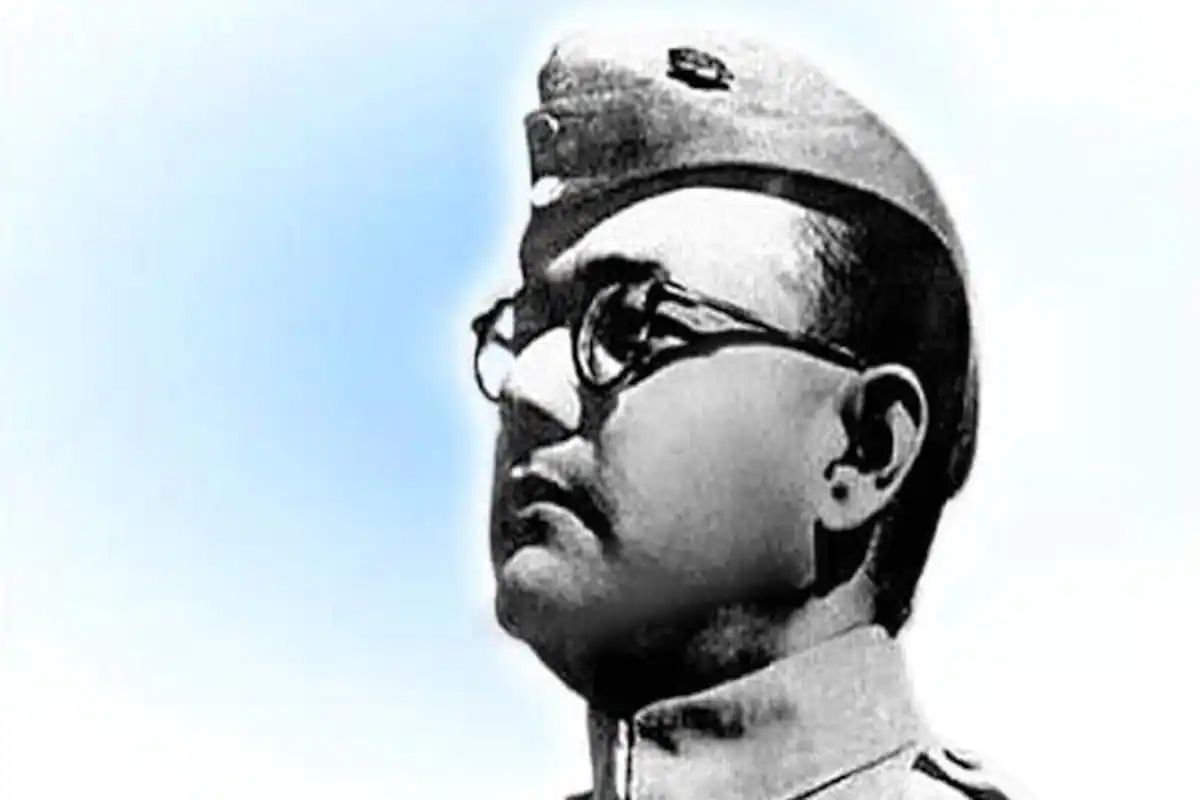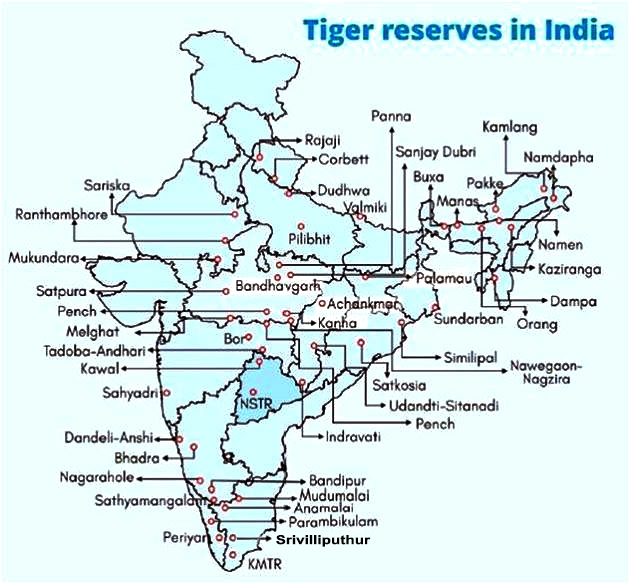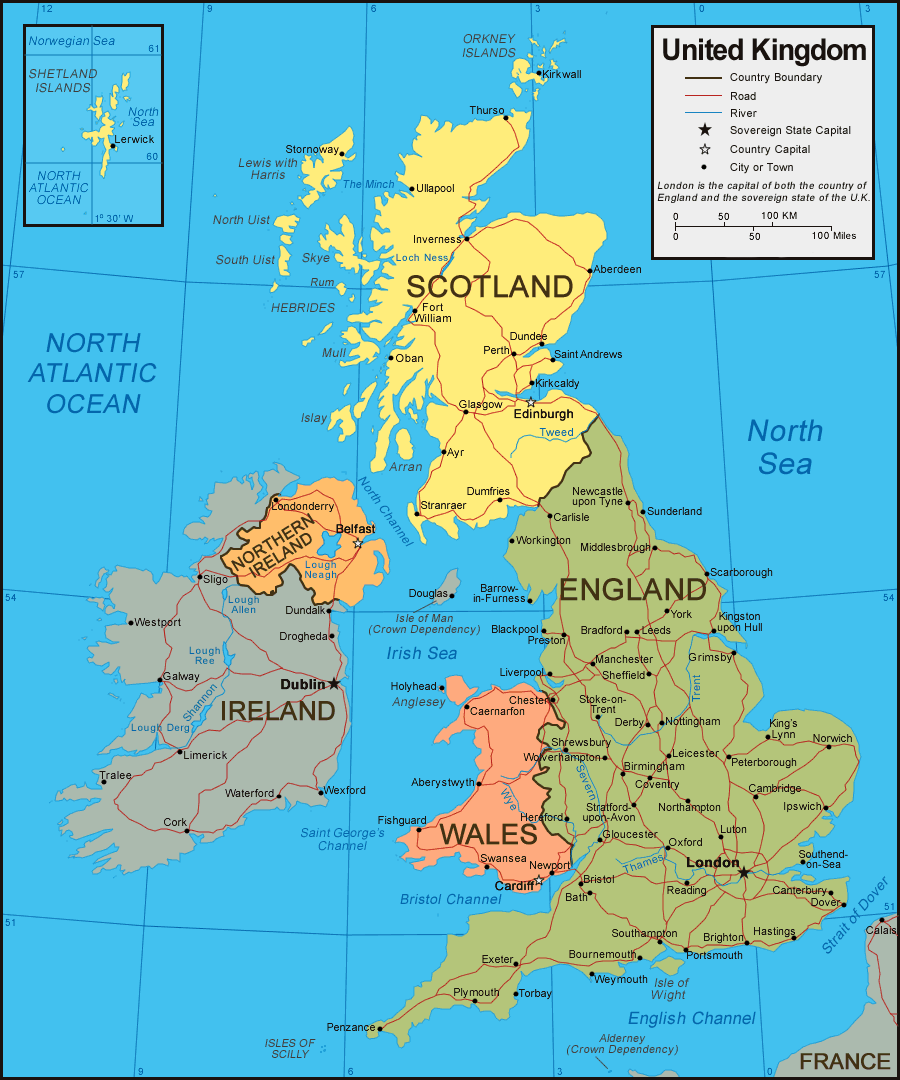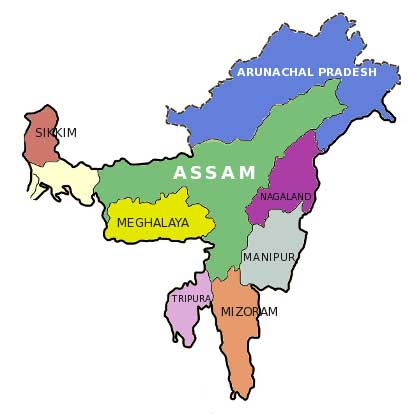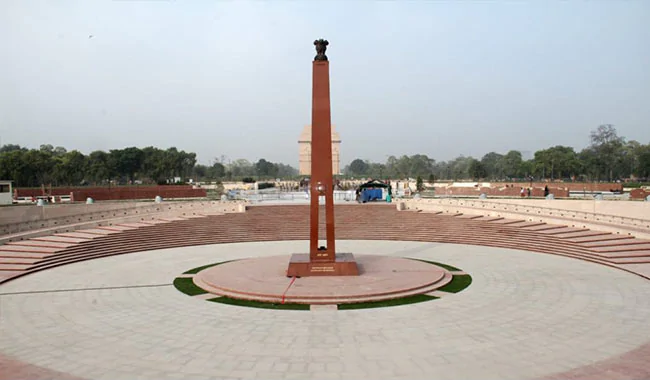Social Issues
SC on Inheritance of Daughters
For Prelims: Rights Issues, Hindu Succession Act, Inheritance of Daughters, Supreme Court, Mitakshara law, Dayabhaga law, Vyavastha Chandrika, Manu
For mains: Indian laws related to inheritance of girls, Schools of Hindu laws, Issues related to Women in India.
Why in News
Recently, the Supreme Court (SC) has ruled that daughters will have equal rights to their father’s property even prior to the enactment of the Hindu Succession Act (HSA) of 1956.
- The case involved a dispute over the property of a person who died in 1949 leaving behind a daughter who also died issueless in 1967.
- Earlier, the trial court held that since the person had died prior to the enforcement of HSA, 1956 therefore the petitioner and her other sisters were not the heirs as on the date of his death and was not entitled to partition of share in the suit properties. Later, the High Court, too, dismissed the appeal against the trial court.
Key Points
- Daughters Inheritance: It ruled that the property of a man who had died without executing a will and is survived only by a daughter will devolve upon the daughter and not others such as his brother.
- Earlier in 2020, the SC has already expanded the Hindu women’s right to be the coparcener (joint legal heir) and inherit ancestral property on terms equal to male heirs.
- Ancient Texts & Judicial Pronouncements: The SC referred to ancient texts (smritis), commentaries by various renowned learned persons and even judicial pronouncements which have recognised the rights of several female heirs, the wives and the daughter’s being the foremost of them.
- Tracing the sources of customary Hindu law on inheritance, the SC discussed Mitakshara law.
- SC also looked into Vyavastha Chandrika, a digest of Hindu Law by Shyama Charan Sarkar Vidya Bhushan which quoted ‘Vrihaspati’ as saying ‘the wife is pronounced successor to the wealth of her husband, in her default, the daughter. As a son, so does the daughter of a man proceed from his several limbs.
- The SC also noted that the book quoted Manu as saying “the son of a man is even as himself, and the daughter is equal to the son. How then can any other inherit his property, notwithstanding the survival of her, who is, as it were, himself ”.
- Old Law: Right of a widow or daughter to inherit the self-acquired property or share received in partition of a coparcenary property of a Hindu male dying intestate is well recognised not only under the old customary Hindu Law.
- If a property of a male Hindu dying intestate is a self-acquired property or obtained in partition of a coparcenary or a family property, the same would devolve by inheritance and not by survivorship, and a daughter of such a male Hindu would be entitled to inherit such property in preference to other collaterals”.
- Property After Woman's Death: The court also said that if a female Hindu dies intestate without leaving any issue, then the property inherited by her from her father or mother would go to the heirs of her father whereas the property inherited from her husband or father-in-law would go to the heirs of the husband.
- In case a female Hindu dies leaving behind her husband or any issue, then Section 15(1)(a) of the HSA 1956 will come into operation and the properties left behind including the properties which she inherited from her parents would devolve simultaneously upon her husband and her issues.
Land Rights and Women in India
- Related Data: Property in India is largely inclined to be passed on to male heirs. This in turn deprives women of agency, financial independence and entrepreneurship. According to the National Family Health Survey-5 , 43% of women respondents reported owning house/land alone or jointly, but doubts remain about women’s ability to actually access and control property.
- In fact, a 2020 University of Manchester working paper found barely 16% of women in rural landowning households own land.
- Patriarchy: In deep patriarchal mores and rural-agrarian settings, property, which is seen as a primary source of wealth, is largely inclined to be passed on to male heirs.
- State Laws: Inheritance laws for agricultural land remain a minefield with conflicting central personal laws and state laws.
- In this regard, states such as Punjab, Haryana,Uttar Pradesh (UP) and even Delhi have regressive inheritance provisions.
- In fact, Haryana twice tried to take away the progressive rights given to women through HSA1956, while in UP since 2016 married daughters aren’t considered primary heirs.
- Ground-level Resistance: There is also a lot of ground-level resistance to registering land for women in several north Indian states. Thus, women’s empowerment and property rights remain an unfinished project.
Hindu Succession Act, 1956:
- About:
- The Mitakshara school of Hindu law codified as the Hindu Succession Act, 1956 governed succession and inheritance of property but only recognised males as legal heirs.
- It applied to everyone who is not a Muslim, Christian, Parsi or Jew by religion. Buddhists, Sikhs, Jains and followers of Arya Samaj, Brahmo Samaj, are also considered Hindus for this law.
- In a Hindu Undivided Family, several legal heirs through generations can exist jointly.
- Traditionally, only male descendants of a common ancestor along with their mothers, wives and unmarried daughters are considered a joint Hindu family. The legal heirs hold the family property jointly.
- Hindu Succession (Amendment) Act, 2005:
- The 1956 Act was amended in September 2005 and women were recognised as coparceners for property partitions arising from 2005.
- Section 6 of the Act was amended to make a daughter of a coparcener also a coparcener by birth “in her own right in the same manner as the son”.
- It also gave the daughter the same rights and liabilities “in the coparcenary property as she would have had if she had been a son”.
- The law applies to ancestral property and to intestate succession in personal property, where succession happens as per law and not through a will.
| Schools of Hindu Laws | |
| Mitakshara Law School | Dayabhaga Law School |
| The term Mitakshara is derived from the name of a commentary written by Vijnaneswara, on the Yajnavalkya Smriti. | The term Dayabhaga is derived from a similarly named text written by Jimutavahana. |
| It is observed in all parts of India and subdivided into the Benares, the Mithila, the Maharashtra and the Dravida schools. | It is observed in Bengal and Assam. |
| A son, by birth acquires an interest in the ancestral property of the joint family. | A son has no automatic ownership right by birth but acquires it on death of his father. |
| All the members enjoy coparcenary rights during the father’s lifetime. | Sons do not enjoy coparcenary rights when the father is alive. |
| A coparcener’s share is not defined and cannot be disposed of. | The share of each coparcener is defined and can be disposed of. |
| A wife cannot demand partition but has the right to a share in any partition between her husband and her sons. | Here, the same right does not exist for the women because the sons cannot demand partition as the father is the absolute owner. |


Indian Polity
OBC Reservation in Local Body Polls
For Prelims: OBC Reservation, Urban Local Bodies.
For Mains: Significance of OBC Reservation in Local Body Elections.
Why in News
Recently, the Supreme Court (SC) while hearing a plea by the Maharashtra government decided to recall its December 2021 order, which stayed 27% reservation for Other Backward Classes (OBCs) in local body elections.
- The Supreme Court has entrusted the Backward Classes Commission with the responsibility of giving political reservation to OBCs in the upcoming local body elections in Maharashtra.
- Maharashtra is not the only state where OBC reservation in local bodies was stayed. In December 2021, the top court passed a similar order for the Madhya Pradesh government, directing the OBC seats to be notified as general category for failing to comply with the three-test criteria (as stated in the 2010 judgement).
- Likewise, the Madhya Pradesh government has filed a similar application, claiming to have 51% OBC population in the state.
Key Points
- Background:
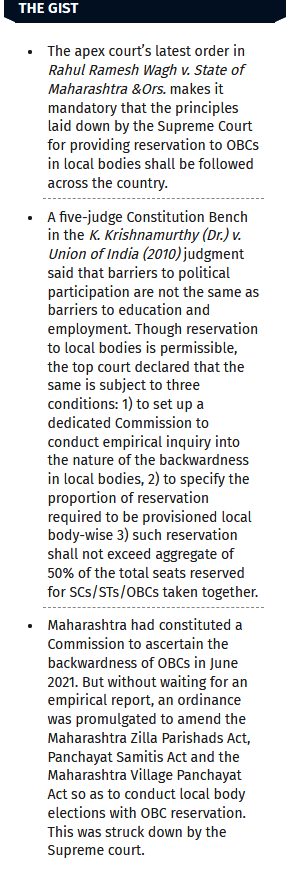
- In March 2021, the SC asked the state government to comply with triple conditions — setting up a dedicated commission for collecting empirical data on the OBC population, specifying the proportion of reservation and ensuring that the cumulative share of reserved seats don’t breach 50% of total seats.
- Following the SC order, the government appointed the dedicated commission for empirical data of OBCs and also promulgated an ordinance to give up to 27% reservation to the OBCs in local bodies without exceeding the 50% ceiling limit of the reservation.
- However, the apex court stayed it in December 2021, saying it cannot be implemented without the empirical data, and asked the State Election Commission (SEC) to convert the OBC seats into the general category and hold the elections.
- Plea:
- The Maharashtra government claimed that the top court’s December order would result in two adverse effects.
- The persons belonging to OBC are deprived of an opportunity to be elected to the elected positions through democratic process and fulfill the aspirations of not only the residents of the OBC community but everyone else, which helps in the development of leadership quality in such communities.
- Such inadequate representation or non-representation of OBCs is strictly contrary to the object, intent and purpose of the Constitutional scheme.
- The state also claimed that it had already complied with two of the three-fold test guidelines by appointing a commission and gathering data.
- The reservation in various districts of Maharashtra is based on the proportion of population of OBCs in the respective districts and is not a blanket reservation of 27% in all the districts in the entire state of Maharashtra.
- As an intermediate measure to justify the 27% OBC quota in local bodies, the state referred to a sample survey which said that the distribution of OBCs in the sample size was found to be 48.6%.
- SC’s Direction:
- The Supreme Court directed the Maharashtra government to submit data on OBCs to the MSCBC (Maharashtra State Commission for Backward Classes) to examine its correctness and make recommendations on their representation in elections for the local bodies.
- Implications:
- The SC’s order has increased the chances of restoring the OBC quota in the upcoming local bodies polls.
- The government data includes the various surveys of the state’s rural development department and urban development department carried out in the local bodies for poverty alleviation, health and education sectors.
- The government is likely to refer to the data of the previous backward classes commission and the census 2011 data as well.
- The government should ensure proper coordination with the MSCBC and the State Election Commission (SEC) and should work together to restore the OBC quota in the local bodies.
The 2010 Judgement
- The five-judge Constitution Bench decision in K. Krishnamurthy (Dr.) v. Union of India (2010) wherein the Supreme Court had interpreted Article 243D(6) and Article 243T(6), which permit reservation by enactment of law for backward classes in panchayat and municipal bodies respectively, to hold that barriers to political participation are not the same as that of the barriers that limit access to education and employment.
- However, for creating a level playing field, reservation may be desirable as mandated by the aforementioned Articles which provide a separate constitutional basis for reservation, as distinct from what are conceived under Article 15 (4) and Article 16 (4) which form the basis for reservation in education and employment.
- Though reservation to local bodies is permissible, the top court declared that the same is subject to empirical finding of backwardness in relation to local bodies as fulfilled through the three tests.


Science & Technology
Dark Matter Shapes Galaxies
For Prelims: Dark Matter, Large Hadron Collider, dark energy, Black Hole
For Mains: Dark Matter, Dark energy, Black Hole, Expansion of Universe
Why in News
Recently, scientists investigating how the shape of dark matter affects the motion of stars in the centre of some galaxies (stellar bars) have found that out-of-plane bending can be explained through dark matter halos in barred galaxies.
- Out of plane bending of the bar in barred galaxies is a rare violent bar thickening mechanism known as buckling.
- A dark halo is the inferred halo of invisible material (dark matter) that permeates and surrounds individual galaxies, as well as groups and clusters of galaxies.
Note
- A barred spiral galaxy is a spiral galaxy with a central bar-shaped structure composed of stars.
- For example, the Milky Way is a disk galaxy made up of stars moving in circular orbits around the center in a flattened disk, with a dense collection of the stars at the center called the bulge.
- These bulges can have shapes ranging from nearly spherical to as flat as the galaxy disk. The Milky Way has a flat boxy or peanut-shaped bulge in its center.
- Such bulges are formed due to thickening of the stellar bars in galaxies.
- One of the violent thickening mechanisms is buckling, where the bar bends out of the plane of the galaxy disk.
- Stellar bar: A bar-shaped accumulation of stars in galaxies.
Key Points
- About Dark Matter:
- Dark matter, though never detected, is believed to be present in the entire universe.
- It is presumed that primordial black holes, those that were formed in the early age of the universe, are a source of dark matter. It was proposed by Professor Stephen Hawking.
- It is believed that combined with dark energy, it makes up more than 95% of the universe.
- Its gravitational force prevents stars in our Milky Way from flying apart.
- However, attempts to detect such dark matter particles using underground experiments, or accelerator experiments including the world's largest accelerator, the Large Hadron Collider (LHC), have failed so far.
- Dark Matter Presence in the Universe:
- Laws of gravity expect us to see stars closer to the center of galaxies rotating faster than the stars on the edge.
- However, in most galaxies, the stars closer to the center and the stars at the edge of the galaxies take almost the same time to make one revolution.
- This implied that something invisible and enveloping the galaxies was giving an extra push to the outer stars, speeding them up.
- This entity has remained as one of the unresolved puzzles in cosmology since the 1930s. It was named `Dark Matter’.
- The material is considered to be a ‘matter’ since it has gravitational attraction and it is ‘dark’ because it does not seem to interact with light (or any part of the electromagnetic spectrum).
- Laws of gravity expect us to see stars closer to the center of galaxies rotating faster than the stars on the edge.
- Dark Matter and Dark Energy:
- While dark matter attracts and holds galaxies together, dark energy repels and causes the expansion of our universe.
- Despite both components being invisible, a lot more is known about dark matter, since its existence was suggested as early as the 1920s, while dark energy wasn’t discovered until 1998.
- About Dark Energy:
- The Big Bang occurred nearly 15 billion years ago and expanded.
- Earlier, astronomers believed that eventually the expansion of the Universe will slow down because of gravity and it will recollapse.
- However, data from the Hubble Telescope suggested that the Universe's expansion is accelerating.
- The astronomers theorize that the faster expansion rate is due to a mysterious, dark force or energy that is pulling galaxies apart.
- The term ‘dark’ is used to denote the unknown.
- The following diagram reveals changes in the rate of expansion since the universe's birth 15 billion years ago.
Black Holes
- It refers to a point in space where the matter is so compressed as to create a gravity field from which even light cannot escape.
- The concept was theorized by Albert Einstein in 1915 and the term ‘black hole’ was coined in the mid-1960s by American physicist John Archibald Wheeler.
- Usually, the black holes belong to two categories:
- One category ranges between a few solar masses and tens of solar masses. These are thought to form when massive stars die.
- The other category is of supermassive black holes. These range from hundreds of thousands to billions of times that of the sun from the Solar system to which Earth belongs.
- In April 2019, the scientists at the Event Horizon Telescope Project released the first-ever image of a Black Hole (more precisely, of its shadow).
- The Event Horizon Telescope is a group of 8 radio telescopes (used to detect radio waves from space) located in different parts of the world.
- Gravitational waves are created when two black holes orbit each other and merge.


Indian History
Netaji Subhas Chandra Bose
For Prelims: History of India and Indian National Movement, Netaji Subhas Chandra Bose
For Mains: Modern Indian History, The Freedom Struggle, INA & Subhash Chandra Bose, Netaji Subhas Chandra Bose and his contribution to freedom struggle
Why in News
Recently, the government has decided to install a grand statue of Netaji Subhas Chandra Bose at India Gate to commemorate his 125th birth anniversary and as part of the year long celebrations.
- The Subhas Chandra Bose Aapda Prabandhan Puraskars, for the years 2019, 2020, 2021 and 2022 in the investiture ceremony will also be conferred.
Subhas Chandra Bose Aapda Prabandhan Puraskar
- The annual Subhas Chandra Bose Aapda Prabandhan Puraskar has been instituted to recognize and honour the invaluable contribution and selfless service rendered by individuals and organisations in India in the field of disaster management.
- The award is announced every year on 23rd January.
- It carries a cash prize of Rs. 51 lakh and a certificate in case of an institution and Rs. 5 lakh and a certificate in case of an individual.
Key Points
- Birth:
- Subhas Chandra Bose was born on 23rd January 1897, in Cuttack, Orissa Division, Bengal Province, to Prabhavati Dutt Bose and Janakinath Bose.
- His Jayanti is celebrated as 'Parakram Diwas' on 23rd January.
- Subhas Chandra Bose was born on 23rd January 1897, in Cuttack, Orissa Division, Bengal Province, to Prabhavati Dutt Bose and Janakinath Bose.
- Education and Early Life:
- In 1919, he had cleared the Indian Civil Services (ICS) examination. Bose, however, resigned later.
- He was highly influenced by Vivekananda's teachings and considered him as his spiritual Guru.
His political mentor was Chittaranjan Das.- He worked as the editor for Das’s newspaper–Forward, and later started his own newspaper, Swaraj.
- Association with Congress:
- He stood for unqualified swaraj (independence), and opposed the Motilal Nehru Report which spoke for dominion status for India.
- He actively participated in the Salt Satyagraha of 1930 and vehemently opposed the suspension of Civil Disobedience Movement and signing of the Gandhi-Irwin Pact in 1931.
- In the 1930s, he was closely associated with left politics in Congress along with Jawaharlal Nehru and M.N. Roy.
- Bose won the congress presidential elections at Haripura in 1938.
- Again in 1939 at Tripuri, he won the presidential elections against Gandhi's candidate Pattabhi Sitarammayya. Due to ideological differences with Gandhi, Bose resigned and left congress. Rajendra Prasad was appointed in his place.
- He founded a new party, 'the Forward Bloc'. The purpose was to consolidate the political left and major support base in his home state Bengal.
- Indian National Army:
- He reached Japanese-controlled Singapore from Germany in July 1943, issued from there his famous call, ‘Delhi Chalo’, and announced the formation of the Azad Hind Government and the Indian National Army on 21st October 1943.
- The INA was first formed under Mohan Singh and Japanese Major Iwaichi Fujiwara and comprised Indian prisoners of war of the British-Indian Army captured by Japan in the Malayan (present-day Malaysia) campaign and at Singapore.
- The INA included both the Indian prisoners of war from Singapore and Indian civilians in South-East Asia. It's strength grew to 50,000.
- The INA fought allied forces in 1944 inside the borders of India in Imphal and in Burma.
- In November 1945, a British move to put the INA men on trial immediately sparked massive demonstrations all over the country.
- Death:
- He is said to have died in 1945 when his plane crashed in Taiwan. However, there are still many conspiracy theories regarding his death.
Biodiversity & Environment
4th Asia Ministerial Conference on Tiger Conservation
For Prelims: Conservation Status of Tiger, Conservation Assured | Tiger Standards (CA|TS), Global Tiger Summit, Project Tiger
For Mains: Importance of Tiger Conservation and related Initiatives, Reasons for Loss of Biodiversity
Why in News
Recently, the 4th Asia Ministerial Conference on tiger conservation was held.
- India’s National Tiger Conservation Authority has also decided to introduce guidelines for the reintroduction of tigers that can be used by other Tiger Range Countries.
Key Points
- About:
- The conference is an important event for reviewing progress towards the Global Tiger Recovery Programme and commitments to tiger conservation.
- It was organized by Malaysia and Global Tiger Forum (GTF).
- India will facilitate Tiger Range Countries towards finalisation of New Delhi declaration for the Global Tiger Summit to be held in Russia later this year (2022).
- A “Pre-Tiger Summit” meeting was held at New Delhi in 2010, wherein the draft declaration on tiger conservation for Global Tiger Summit was finalised.
- India is one of the Founding members of the intergovernmental platform of Tiger Range Countries – Global Tiger Forum.
- Over the years, GTF has expanded its programme on multiple thematic areas, while working closely with the Government of India, tiger states in India and tiger range countries.
- Tiger Range Countries in GTF: Bangladesh, Bhutan, India, Cambodia, Nepal, Myanmar and Vietnam.
- Significance of Tiger Conservation:
- Vital in Regulating Ecological Processes:
- Tigers, the top predators in the ecosystem, are vital in regulating and perpetuating ecological processes.
- Forests are known to provide ecological services like clean air, water, pollination, temperature regulation etc.
- Tigers, the top predators in the ecosystem, are vital in regulating and perpetuating ecological processes.
- Maintaining Food Chain:
- It is a top predator which is at the apex of the food chain and keeps the population of wild ungulates (primarily large mammals) in check.
- Thus, Tiger helps in maintaining the balance between prey herbivores and the vegetation upon which they feed.
- Vital in Regulating Ecological Processes:
- Conservation Status of Tiger:
- Indian Wildlife (Protection) Act, 1972: Schedule I
- International Union for Conservation of Nature (IUCN) Red List: Endangered.
- Convention on International Trade in Endangered Species of Wild Fauna and Flora (CITES): Appendix I.
- TIger Population in India:
- India is home to over 70% of the tiger population globally.
- India is home to 53 tiger reserves spread across 18 states and the last tiger census of 2018 showed a rise in the tiger population.
- Guru Ghasidas (Chattisgarh) is the 53rd Tiger Reserve.
- India has achieved the remarkable feat of doubling the tiger population in 2018 itself, 4 years ahead of the targeted year 2022 of the St. Petersburg Declaration on tiger conservation.
- Related Steps taken:
- Conservation Assured | Tiger Standards (CA|TS):
- 14 Tiger Reserves in India have already been awarded with international CA|TS accreditation and efforts are on to bring in more Tiger Reserves under CA|TS accreditation.
- Project Tiger:
- It is a Centrally Sponsored Scheme of the Ministry of Environment, Forests and Climate Change (MoEFCC) launched in 1973. It provides havens for tigers in the country’s national parks.
- Budgetary Allocation:
- The budgetary allocation for tiger conservation has increased from Rs 185 crore in 2014 to Rs 300 crore in 2022.
- Helping Frontline Staff:
- The Frontline staff, which is an important pillar of tiger conservation, have extended Rs 2 lakh life cover to each contractual/temporary worker under e-Sharm, a recent initiative of the Ministry of Labour and Employment and Rs 5 lakh health cover under Ayushman Yojana.
- Conservation Assured | Tiger Standards (CA|TS):
International Relations
Collaboration between India and UK on Food Security
For Prelims: India-Uk Partnership on Various Fields.
For Mains: Significance of India-UK Relations and Challenges.
Why in News
Recently, the Union Minister of Science & Technology addressed the joint India-UK meet on “Sustaining Food Production under Environmental Stress” and called for collaboration between the two nations on issues of mutual concern like achieving the goals of Food Security and Zero Hunger.
Key Points
- Call for Global Collaborations in Various Fields:
- India and the UK must invite global collaborations in various dimensions of science like agriculture, medicine, food, pharma, engineering or defence.
- India-UK joint collaboration may include programmes like student exchange, basic research, technology development, product development as well as product/process demonstration and their implementation in joint collaboration.
- Issue of Shrinking Arable Land:
- Dwelling on the issue of Sustainable Food Production, the South Asian region is facing the shrinking arable land, besides the problem of Global Climate Change that needs to be addressed.
- Arable land in South Asia was reported at 43.18% in 2018 which has been stagnant since the early 1970s and recently declining.
- Growth yields and more intensive use of land will account for all of the growth in crop production and will also compensate for losses in the arable land area.
- Dwelling on the issue of Sustainable Food Production, the South Asian region is facing the shrinking arable land, besides the problem of Global Climate Change that needs to be addressed.
- Improving Quality of Nutritional Foods:
- NABI (National Agri-Food Biotechnology Institute) could provide an impetus to the nations need for addressing nutritional security even under the climatic changes happening around the world.
- NABI is a premier institute that works at the interface of Agri-Food and Nutrition Biotechnology.
- NABI (National Agri-Food Biotechnology Institute) could provide an impetus to the nations need for addressing nutritional security even under the climatic changes happening around the world.
- Joint Funding to Address the Challenges:
- Underlining that the global pattern of food production and distribution may need to shift significantly as climate change progresses.
- Need of joint funding to develop a coherent and stakeholder-relevant R&D (Research and Development) program that will address this challenge.
India-UK Partnership
- About:
- India and the UK are vibrant democracies, with a partnership built on our shared history and rich culture.
- The diverse Indian diaspora in the UK, which acts as a “Living Bridge”, adds further dynamism to the relations between the two countries.
- The UK is one of the largest investors in India, among the G20 countries.
- Recently, both countries have announced their intent to negotiate a comprehensive Free Trade Agreement (FTA), including consideration of an interim trade agreement to deliver early gains.
- As part of the UK’s tilt towards the Indo-Pacific region, the UK Carrier Strike Group (CSG) is conducting engagements with Singapore, the Republic of Korea, Japan and India.
- Roadmap 2030:
- For elevating bilateral ties to a “Comprehensive Strategic Partnership” both Countries adopted Roadmap 2030 in 2021.
- It provides a framework for UK-India relations across health, climate, trade, education, science and technology, and defense.
- Security & Defence:
- Cooperation on Maritime Domain Awareness:
- Includes invitation to the UK to join India’s Information Fusion Centre in Gurgaon and an ambitious exercise programme which includes joint trilateral exercises.
- Light Combat Aircraft Mark 2:
- Support India’s indigenous development of the Light Combat Aircraft Mark 2.
- Exercises:
- Air Force Exercise ‘Indradhanush’.
- Navy Exercise Konkan.
- Army Exercise ‘Ajeya Warrior’
- Cooperation on Maritime Domain Awareness:
- Climate Change:
- India and the UK jointly launched a new flagship international initiative at the COP26 World Leaders' Summit in Glasgow, backed by over 80 countries, to dramatically accelerate the global transition to a clean powered world.
- The new initiative, called ‘Green Grids Initiative – One Sun One World One Grid’ (GGI-OSOWOG), is aimed at accelerating the development and deployment of interconnected electricity grids across continents, countries and communities, and improve energy access of the poorest through mini-grids and off-grid solutions.


Important Facts For Prelims
Statehood Day of Manipur, Meghalaya and Tripura
Why in News
On the Statehood Day of Manipur, Meghalaya and Tripura (21st January), Prime Minister and other leaders praised the traditions and culture of the three northeast states.
- On 21st January, 1972, all the three states became full-fledged states under the North Eastern Region (Reorganisation) Act, 1971.
Key Points
- Merger of Manipur with India:
- Before 15th August 1947, peaceful negotiations had brought almost all states whose territories were contiguous to the new boundaries of India, into the Indian Union.
- The rulers of most of the states signed a document called the ‘Instrument of Accession’ which meant that their state agreed to become a part of the Union of India.
- A few days before Independence, the Maharaja of Manipur, Bodhachandra Singh, signed the Instrument of Accession with the Indian government on the assurance that the internal autonomy of Manipur would be maintained.
- Under the pressure of public opinion, the Maharaja held elections in Manipur in June 1948 and the state became a constitutional monarchy. Thus Manipur was the first part of India to hold an election based on universal adult franchise.
- In the Legislative Assembly of Manipur there were sharp differences over the question of merger of Manipur with India. The Government of India succeeded in pressuring the Maharaja into signing a Merger Agreement in September 1949, without consulting the popularly elected Legislative Assembly of Manipur.
- Merger of Tripura with India:
- Tripura was a princely state till the merger with the Indian union on 15th November, 1949.
- The last king Bir Bikram who was on the throne, immediately before India's independence, died on 17th May, 1947.
- After his demise, his minor son Kirri Bikram Mannikya took the throne of Tripura kingdom, but he could not rule as he was minor.
- So his widow queen Kanchan Prabha took the charge of regency of Tripura and took over the administrative charges.
- She was instrumental for Merger of the Tripura kingdom in the Indian Union.
- Merger of Meghalaya into India
- In 1947 the rulers of the Garo and Khasi region acceded to the newly independent country of India.
- Meghalaya, a small hilly state located in the North Eastern Region of India, came into existence as an autonomous state within the state of Assam on 2nd April 1970 comprising the United Khasi and Jaintia Hills and the Garo Hills districts.
- Changes Made in 1972:
- In 1972, the political map of Northeast India underwent a major change.
- The two Union Territories of Manipur and Tripura and the Sub-State of Meghalaya got statehood.


Important Facts For Prelims
Relocating the Amar Jawan Jyoti to National War Memorial
Why in News
In a historic move, Amar Jawan Jyoti merged with the National War Memorial flame.
Key Points
- Amar Jawan Jyoti:
- Established in 1972, it was to mark India’s victory over Pakistan in the 1971 War, which resulted in the creation of Bangladesh.
- The then Prime Minister Indira Gandhi had inaugurated it on Republic Day 1972, after India defeated Pakistan in December 1971.
- The eternal flame at the Amar Jawan Jyoti underneath India Gate in central Delhi was an iconic symbol of the nation’s tributes to the soldiers who have died for the country in various wars and conflicts since Independence.
- The India Gate memorial was built by the British government in memory of the British Indian Army soldiers who lost their lives between 1914-1921.
- Reasons for the Relocation:
- The names inscribed on the India Gate are of only some martyrs who fought for the British in World War 1 and the Anglo Afghan War & thus is a symbol of our colonial past.
- The names of all Indian martyrs from all the wars, including “1971 and wars before and after it are housed at the National War Memorial.
- National War Memorial:
- Inaugurated in 2019, it is around 400 meters from India Gate.
- The layout of the structure comprises four concentric circles, named:
- the "Amar Chakra" or Circle of Immortality,
- the "Veerta Chakra" or Circle of Bravery,
- the "Tyag Chakra" or Circle of Sacrifice and
- the "Rakshak Chakra" or Circle of Protection.
- The proposal for a National War Memorial was first made in the 1960s.
- The memorial is dedicated to soldiers who laid down their lives defending the nation during the Sino-Indian war in 1962, Indo-Pak wars in 1947, 1965 and 1971, Indian Peace Keeping Force Operations in Sri Lanka and in the Kargil Conflict in 1999.
- The National War Memorial also commemorates the soldiers who participated and made supreme sacrifices in United Nations peace-keeping missions, Humanitarian Assistance Disaster Relief (HADR) operations, counterinsurgency operations and Low-Intensity Conflict Operations (LICO).

